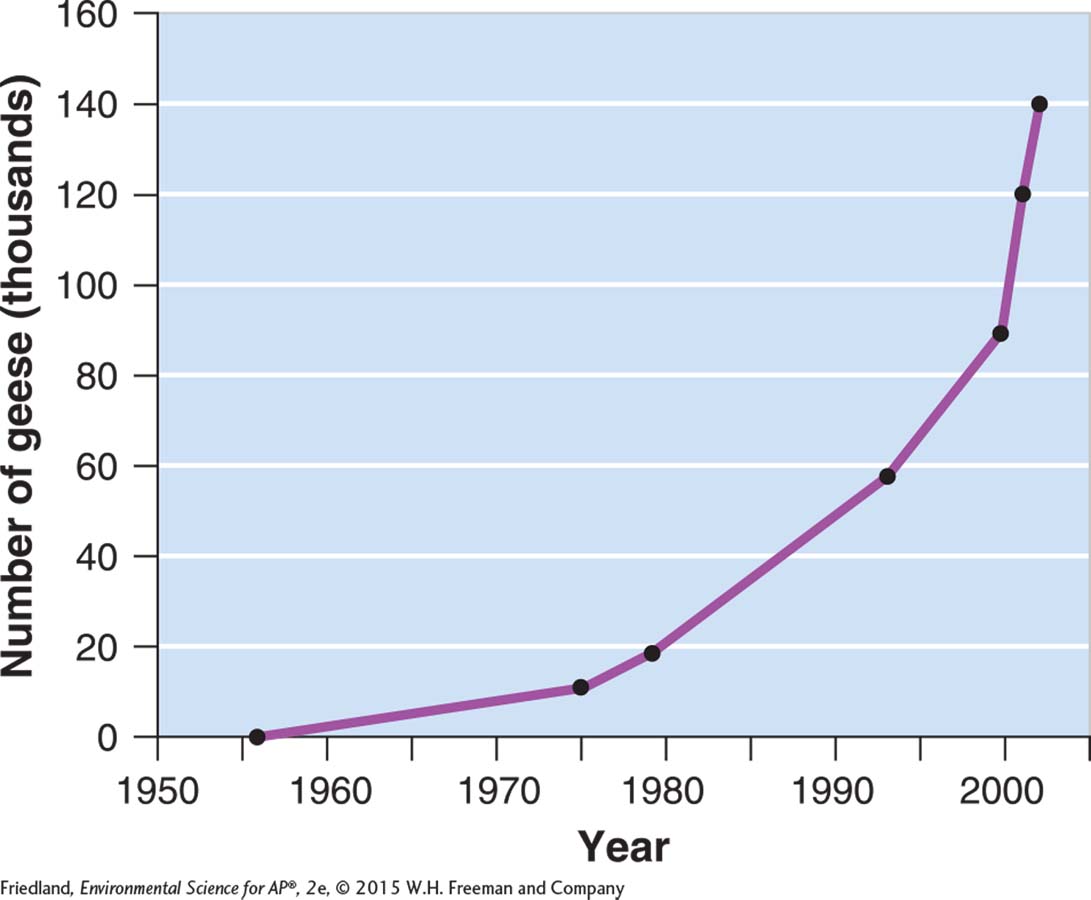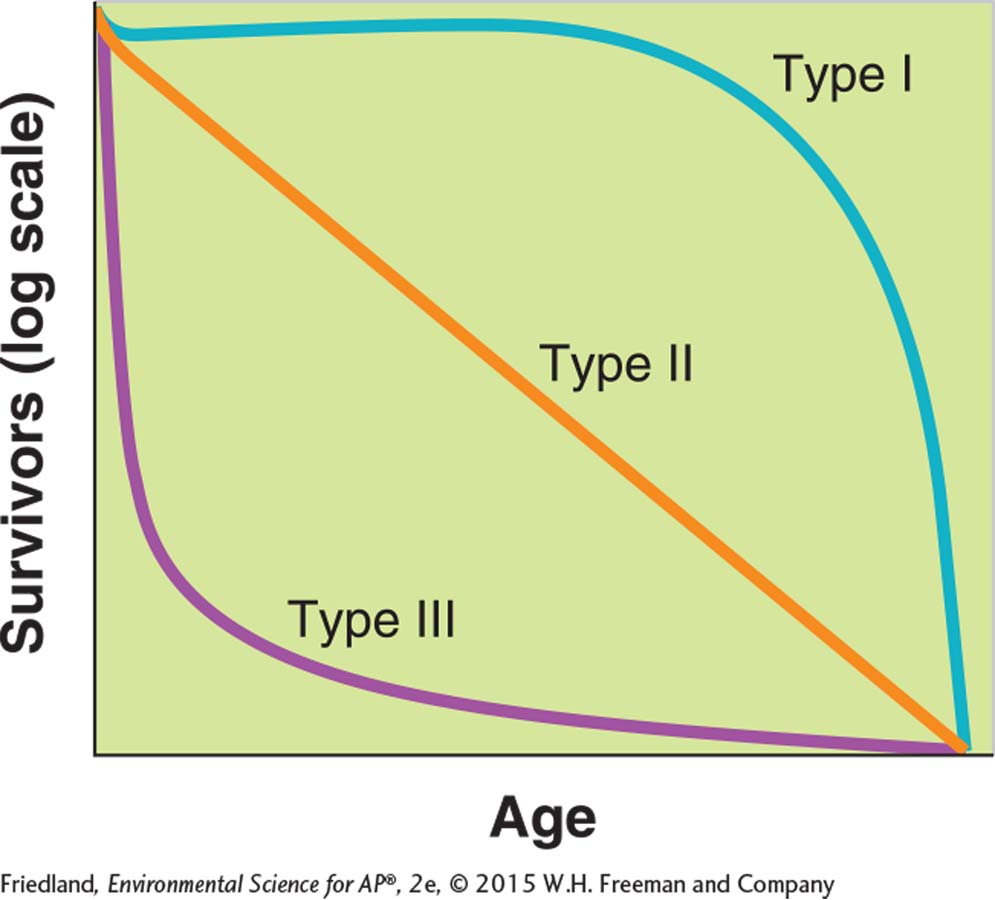Chapter 6 AP® Environmental Science Practice Exam
221
Section 1: Multiple-
Choose the best answer for questions 1–
Question 1
1. Which is NOT an example of a density-
Drought
Competition
Forest fire
Hurricane
Flood
Question 2
2. As the size of a white-
the carrying capacity of the environment for white-
tailed deer will be reduced. a volcanic eruption will have a greater proportional effect than it would on a smaller population.
the effect of limiting resources will decrease.
the number of gray wolves, a natural predator of white-
tailed deer, will increase. white-
tailed deer are more likely to become extinct.
Question 3
3. The following graph shows population growth of Canada geese in Ohio between 1955 and 2002.

This graph can best be described as:
an exponential growth curve.
a logistic growth curve.
a stochastic growth curve.
oscillation between overshoot and die-
off. approaching the carrying capacity.
Question 4
4. Which is NOT a true statement based on the logistic growth model?
Population growth is limited by density-
dependent factors. A population will initially increase exponentially and then level off as it approaches the carrying capacity of the environment.
Future population growth cannot be predicted mathematically.
Population growth slows as the number of individuals approaches the carrying capacity.
A graph of population growth produces an S-
shaped growth curve over time.
Question 5
5. Which characteristics are typical of r-selected species?
They produce many offspring in a short period of time.
They have very low survivorship early in life.
They take a long time to reach reproductive maturity.
I only
II only
III only
I and II
II and III
Question 6
6. A high intrinsic growth rate would most likely be characteristic of
a K-selected species such as elephants.
an r-selected species such as the American bullfrog.
a K-selected species that lives close to its carrying capacity.
a species that is near extinction.
a species with a low reproductive rate that takes a long time to reach reproductive maturity.
222
Question 7
7. The following graph presents three survivorship curves.

Choose the description that best describes the graph.
Type I could represent the house mouse, which is a typical r-selected species.
Type II could be the average of r-selected and K-selected species in a specific area.
Type III could represent elephants, which are typical K-selected species.
Type I could represent an oak tree species that experiences very low survivorship early and late in life.
Type II could represent a coral species that has a constant decline in survivorship throughout its life.
Question 8
8. In the coniferous forests of Oregon, eight species of woodpeckers coexist. Four species select their nesting sites based on tree diameter, while the fifth species nests only in fir trees that have been dead for at least 10 years. The sixth species also nests in fir trees, but only in live or recently dead trees. The two remaining species nest in pine trees, but each selects trees of different sizes. This pattern is an example of
resource partitioning.
commensalism.
predation.
predator-
mediated competition. a keystone species.
Question 9
9. Which statement about ecological succession is correct?
Secondary succession begins in a community lacking soil.
Primary succession occurs over a shorter time span than secondary succession.
Succession is influenced by competition for limiting resources such as available soil, moisture, and nutrients.
In forest succession, less shade-
tolerant trees replace more shade- tolerant trees. Forest fires and hurricanes lead to primary succession because a soil base still exists.
Question 10
10.Which sequence of secondary succession would be likely to occur in abandoned farmland in the eastern United States?
Bare soil, lichens, mosses, grasses, deciduous trees
Bare rock, lichens, mosses, grasses, shrubs, mixed shade-
and sunlight- tolerant trees Bare soil, grasses and wildflowers, shrubs, shade-
tolerant trees Bare soil, grasses and wildflowers, shrubs, sunlight-
tolerant trees, shade- tolerant trees Bare rock, grasses and wildflowers, lichens, mosses, shrubs, coniferous trees
Question 11
11.The theory of island biogeography suggests that species richness is affected by which of the following factors?
Island distance from mainland
How the island is formed
Island size
I only
II only
III only
I and III
II and III
Question 12
12.Which combination of factors would result in the highest biodiversity?
A small island, close to a continent
A large island, close to a continent
A medium island, distant from a continent
A small island, distant from a continent
A large island, distant from a continent
223
Section 2: Free-
Write your answer to each part clearly. Support your answers with relevant information and examples. Where calculations are required, show your work.
Question 1
1. The California Department of Fish and Wildlife is developing a plan to connect mountain “habitat islands” that are separated by open areas of flat, arid land in the deserts of southeastern California. These mountain areas are habitats for desert bighorn sheep (Ovis canadensis), which move extensively among the islands through habitat corridors. The habitat corridors provide opportunities for recolonization, seasonal migration, and maintenance of genetic variation among the metapopulation of desert bighorn sheep.
Explain what is meant by a metapopulation and how it relates to the desert bighorn sheep. (1 point)
Identify two density-
dependent factors and one density- independent factor that could affect the populations of desert bighorn sheep. (3 points) Explain the consequences to the desert bighorn sheep population if the plan to connect the mountain habitat islands is not implemented. (2 points)
Explain how the theory of island biogeography applies to the mountainous areas of southeastern California. (4 points)
Question 2
2. Read the following information, which was posted in the great apes exhibit of the Fremont Zoo, and answer the questions that follow.
The western lowland gorilla (Gorilla gorilla) lives in the moist tropical rainforests of western Africa. The gorillas’ primary diet consists of fruits, leaves, foliage, and sometimes ants and termites. Occasionally they venture onto farms and feed on crops. Their only natural enemy is the leopard, the only animal other than humans that can successfully kill an adult gorilla. However, disease, particularly the Ebola virus, is threatening to decimate large populations of these gorillas in Congo.
The western lowland gorilla has a life span of about 40 years and produces one offspring every 4 years. Males usually mate when they are 15 years old. Females reach sexual maturity at about 8 years of age, but rarely mate before they are 10 years old.
Based on the information above, is the western lowland gorilla an r-selected or a K-selected species? Provide evidence to support your answer. (3 points)
Identify and explain four community interactions that involve the western lowland gorilla. (4 points)
Explain what is meant by secondary succession and describe how it may be initiated in a tropical forest. (3 points)